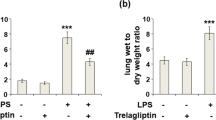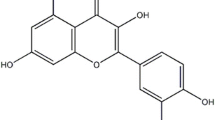Abstract
The aim of this study is to investigate the effects of dexpanthenol in a model of acute lung injury (ALI) induced by lipopolysaccharides (LPS). Lung injury was induced by exposure to atomized LPS. Mice were randomly divided into four groups: control group; Dxp (500 mg/kg) group; LPS group; LPS + Dxp (500 mg/kg) group. The effects of dexpanthenol on LPS-induced neutrophil recruitment, cytokine levels, total protein concentration, myeloperoxidase (MPO), malondialdehyde (MDA), superoxide dismutase (SOD), and glutathione (GSH) contents were examined. Additionally, lung tissue was examined by histology to investigate the changes in pathology in the presence and absence of dexpanthenol. In LPS-challenged mice, dexpanthenol significantly improved lung edema. Dexpanthenol also markedly inhibited the LPS-induced neutrophiles influx, protein leakage, and release of TNF-α and IL-6 in bronchoalveolar lavage fluid (BALF). Furthermore, dexpanthenol attenuated MPO activity and MDA contents and increased SOD and GSH activity in the LPS-challenged lung tissue. These data suggest that dexpanthenol protects mice from LPS-induced acute lung injury by its anti-inflammatory and anti-oxidative activities.





Similar content being viewed by others
References
Bein, T., et al. 2016. The standard of care of patients with ARDS: ventilatory settings and rescue therapies for refractory hypoxemia. Intensive Care Medicine 5: 699–711.
Galvin, I.M., et al. 2013. Partial liquid ventilation for preventing death and morbidity in adults with acute lung injury and acute respiratory distress syndrome. Cochrane Database of Systematic Reviews 2013: CD003707.
Kim, W.Y., et al. 2016. Sepsis and acute respiratory distress syndrome: recent update. Tuberculosis and Respiratory Disease (Seoul) 2: 53–57.
Ebner, F., et al. 2002. Topical use of dexpanthenol in skin disorders. American Journal of Clinical Dermatology 6: 427–433.
Wong, R.K., et al. 2013. Clinical practice guidelines for the prevention and treatment of acute and late radiation reactions from the MASCC Skin Toxicity Study Group. Support Care Cancer 10: 2933–2948.
Cagin, Y.F., et al. 2016. Beneficial effects of dexpanthenol on mesenteric ischemia and reperfusion injury in experimental rat model. Free Radical Research 3: 354–365.
Ermis, H., et al. 2013. Protective effect of dexpanthenol on bleomycin-induced pulmonary fibrosis in rats. Naunyn-Schmiedeberg’s Archives of Pharmacology 12: 1103–1110.
Etensel, B., et al. 2007. Dexpanthenol attenuates lipid peroxidation and testicular damage at experimental ischemia and reperfusion injury. Pediatric Surgery International 2: 177–181.
Karadag, A., et al. 2015. Protective effects of dexpanthenol in an experimental model of necrotizing enterocolitis. Journal of Pediatric Surgery 7: 1119–1124.
Chen, H., et al. 2010. The value of the lipopolysaccharide-induced acute lung injury model in respiratory medicine. Expert Review of Respiratory Medicine 6: 773–783.
Matute-Bello, G., et al. 2008. Animal models of acute lung injury. American Journal of Physiology. Lung Cellular and Molecular Physiology 3: L379–L399.
Takano, Y., et al. 2011. 1alpha,25-Dihydroxyvitamin D(3) inhibits neutrophil recruitment in hamster model of acute lung injury. Steroids 12: 1305–1309.
Schingnitz, U., et al. 2010. Signaling through the A2b adenosine receptor dampens endotoxin-induced acute lung injury. Journal of Immunology 9: 5271–5279.
Butt, Y., et al. 2016. Acute lung injury: a clinical and molecular review. Archives of Pathology & Laboratory Medicine 4: 345–350.
Grommes, J., et al. 2011. Contribution of neutrophils to acute lung injury. Molecular Medicine 3–4: 293–307.
Abraham, E., et al. 2000. Neutrophils as early immunologic effectors in hemorrhage- or endotoxemia-induced acute lung injury. American Journal of Physiology. Lung Cellular and Molecular Physiology 6: L1137–L1145.
Zhou, X., et al. 2012. Neutrophils in acute lung injury. Frontiers in Bioscience (Landmark Edition) 2278–2283.
Bhatia, M., et al. 2004. Role of inflammatory mediators in the pathophysiology of acute respiratory distress syndrome. Journal of Pathology 2: 145–156.
Lee, I.T., et al. 2012. Role of NADPH oxidase/ROS in pro-inflammatory mediators-induced airway and pulmonary diseases. Biochemical Pharmacology 5: 581–590.
Sharp, C., et al. 2015. Advances in understanding of the pathogenesis of acute respiratory distress syndrome. Respiration 5: 420–434.
Cho, H.Y., et al. 2007. Genetic mechanisms of susceptibility to oxidative lung injury in mice. Free Radical Biology and Medicine 4: 433–445.
Carnesecchi, S., et al. 2012. Nox enzymes: potential target for the treatment of acute lung injury. Cellular and Molecular Life Sciences 14: 2373–2385.
Christofidou-Solomidou, M., et al. 2006. Antioxidant strategies in respiratory medicine. Treatments in Respiratory Medicine 1: 47–78.
Ueda, J., et al. 2008. Decreased pulmonary extracellular superoxide dismutase during systemic inflammation. Free Radical Biology and Medicine 6: 897–904.
Acknowledgments
This study was supported by grants from the Education Bureau of Guangzhou (no. 1201430812 and no. 1201581610), Guangzhou Medical University (No.2013C31) and National Natural Science Foundation of China (no. 81402992).
Author information
Authors and Affiliations
Corresponding author
Ethics declarations
Conflict of Interest
The authors declare that they have no competing interests.
Additional information
Wan li-mei and Tan jie contributed equally to this work.
Rights and permissions
About this article
Cite this article
Li-Mei, W., Jie, T., Shan-He, W. et al. Anti-inflammatory and Anti-oxidative Effects of Dexpanthenol on Lipopolysaccharide Induced Acute Lung Injury in Mice. Inflammation 39, 1757–1763 (2016). https://doi.org/10.1007/s10753-016-0410-7
Published:
Issue Date:
DOI: https://doi.org/10.1007/s10753-016-0410-7




